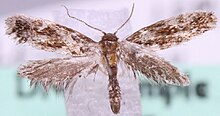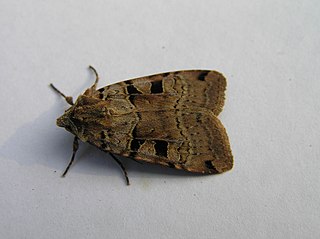
The double square-spot is a moth of the family Noctuidae. It is distributed through most of Europe except Portugal, the Mediterranean islands and northernmost Fennoscandia. In the East, the species ranges East across the Palearctic to Siberia and in the South-East to the Black Sea and in Iran. It rises to a height of about 2,000 metres (6,600 ft) in the Alps.

Parascotia fuliginaria, the waved black, is a species of moth of the family Erebidae. It is found in Europe as far east as the Ural Mountains, in Armenia and Asia Minor, and is an introduced species in North America.

Setina irrorella, the dew moth, is a moth of the family Erebidae. The species was first described by Carl Linnaeus in his 1758 10th edition of Systema Naturae. It is found in the Palearctic from Ireland, then through Europe and east to northern and central Asia to the Pacific Ocean. It is missing in the high north and parts of the Mediterranean region. It is found also in the limestone Alps up to 2,000 meters above sea level.

Morophaga choragella is a moth of the family Tineidae. It is found in Europe.

Tinea pellionella, the case-bearing clothes moth, is a species of tineoid moth in the family Tineidae, the fungus moths. This species has a cosmopolitan distribution, occurring nearly worldwide.

Nemapogon cloacella, the cork moth, is a species of tineoid moth. It belongs to the fungus moth family (Tineidae), and therein to the subfamily Nemapogoninae. Its junior synonym N. infimella was established by G.H. Heydenreich in the 1851 volume of his Lepidopterorum Europaeorum Catalogus Methodicus, but many sources still attribute it to G.A.W. Herrich-Schäffer, who supposedly narrowly beat Heidenreich in (re)describing the species. But as it seems, Herrich-Schäffer was merely one of the first to use the name proposed by Heydenreich, as the volume of his Systematische Bearbeitung der Schmetterlinge von Europa where he discussed the cork moth was not published until 1853 or 1854. That all nonwithstanding, the species had been already validly described by A.H. Haworth in the 1828 volume of Lepidoptera Britannica.

Lygephila craccae, the scarce blackneck, is a moth of the family Erebidae. It is found in temperate Europe and across the Palearctic to the Altai Mountains, Korea, Japan and China.

Idia americalis, the American idia or American snout, is a litter moth of the family Erebidae. The species was first described by Achille Guenée in 1854. It is commonly found in moist forests in North America, ranging from southern Canada to Florida and Texas. It is nocturnal and can be lured by sugar baits and light traps.

Thumatha senex, the round-winged muslin, is a moth of the family Erebidae. It is found in northern and central Europe, the Alps, northern Asia Minor, the Crimea and south-western Siberia.

Lichenaula lichenea is a species of moth of the family Xyloryctidae. It is known in Australia from the Australian Capital Territory, New South Wales and Queensland.
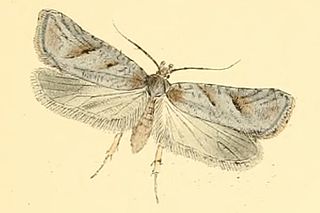
Exaeretia allisella is a moth of the family Depressariidae. It is found in most of northern and central Europe, Siberia, the Russian Far East, Mongolia and northern and central China.
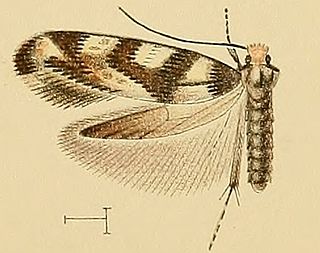
Infurcitinea toechophila is a moth of the family Tineidae. It is found on the Canary Islands.
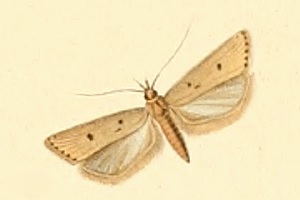
Acompsia antirrhinella is a moth of the family Gelechiidae. It is found in southern France, Andorra and Spain.

Erechthias grayi is a moth of the family Tineidae. It is endemic to Ascension Island.

Haplotinea insectella, the drab clothes moth or fungus grain moth, is a moth of the family Tineidae. It was described by Johan Christian Fabricius in 1794. It is found in all of Europe, except Ireland, the Iberian Peninsula and the western and southern part of the Balkan Peninsula. It is also found in North America. The species is often found in warehouses, granaries, mills and farm buildings.

Infurcitinea ignicomella is a moth of the family Tineidae. It was described by Heydenreich in 1851. It is found in large parts of Europe, except Ireland, Great Britain, Belgium, the Iberian Peninsula, Ukraine and most of the Balkan Peninsula.
Triaxomera puncticulata is a moth of the family Tineidae. It found in Japan.
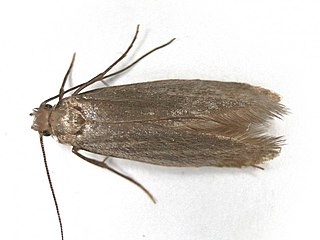
Tinea columbariella is a moth belonging to the family Tineidae. The species was first described by Wocke in 1877.
Tinea flavescentella is a species of moth belonging to the family Tineidae. It is native to Western Europe. The wingspan is 8–17 mm. Head with pale yellow hair tuts. Antennae just over half the front wing length. The forewings are greyish yellow with two or three grey-brown spots and a faint hyaline spot at the base. Hindwings grey. Certain identification requires examination of the genitalia. Flies at night in August. It is found indoors where fur and wool goods are kept.
Tinea dubiella is a species of moth belonging to the family Tineidae.
Content in this edit is translated from the existing Norwegian Wikipedia article at no:Infurcitinea argentimaculella; see its history for attribution.
